Photography by Zaina Khalid Azim
Interviewed & Edited by Emily Law, Kane Hong, & Eric Nguyen
Emily: Thank you for making time; it means a lot, especially considering how last-minute this was.
Eric: Indeed, you’re one of our final contributors. We’ll be conducting this in an interview style. As we’ve already discussed with you, you’ll be the interviewee. Maybe Kane and Emily can handle most of the questions. While the meeting is recorded, I’ll take independent notes. Sounds good?
Emily: Don’t mind our logistical stuff. As you can see, we are very well planned. To get us started, would you mind introducing yourself? The basics: name, year, and anything you’d like to share about yourself?
Zaina: I’m Zaina, a fourth-year informatics major. I recently took up film photography as a hobby, which is why I enjoy sending these photos.
Emily: Along those lines, how did you get into photography?
Zaina: It wasn’t anything special; I found my dad’s old film camera in his closet one day and decided to try using it. I started taking photos last summer. Initially, I was worried that the old film wouldn’t work or could be expired, but it worked out, and I’ve been taking photos ever since.
Kane: It’s fascinating that this hobby is fairly recent. Could you describe your process of getting used to the camera? How did it feel starting out versus now?
Zaina: When I first started, I was inexperienced. Many of my early photos have my finger in the frame, and I didn’t know how to use the flash. I’ve become more comfortable with the camera over time and more deliberate about what I want to capture. I remember my first roll of film was filled with random things like cats or the sky. Now, I take the time to put film in my camera only if I’m going to capture something I really want to.
Emily: The photos you submitted seem to convey a similar feeling. Can you tell us about the day you took those pictures?
Zaina: That day was special. Most of my relatives are in India, so I don’t have much family here in the US. They were here this past winter for my brother’s wedding and we went to La Jolla. I wanted to capture that experience on film. Despite my lack of experience with portraits, I enjoyed the moment. The lighting and weather were perfect, so the photos came out really well.
Eric: I’d like to follow up on that: You mentioned your fascination with the ephemerality of your work. What aspects of ephemerality do you find most compelling, and how do you capture these fleeting moments?
Zaina: To me, ephemerality is about capturing memories that might be hard for me to remember in the future. I enjoy film photography because it helps me remember these moments better than digital photography. I spend a lot of time deciding what photos to take, which helps me remember every photo. When I send a film roll to get developed, I think about how each photo might turn out. That day I captured various moments, from a beautiful gazebo marking the end of the day to a man blowing gigantic bubbles and seals sitting on rocks close to us.
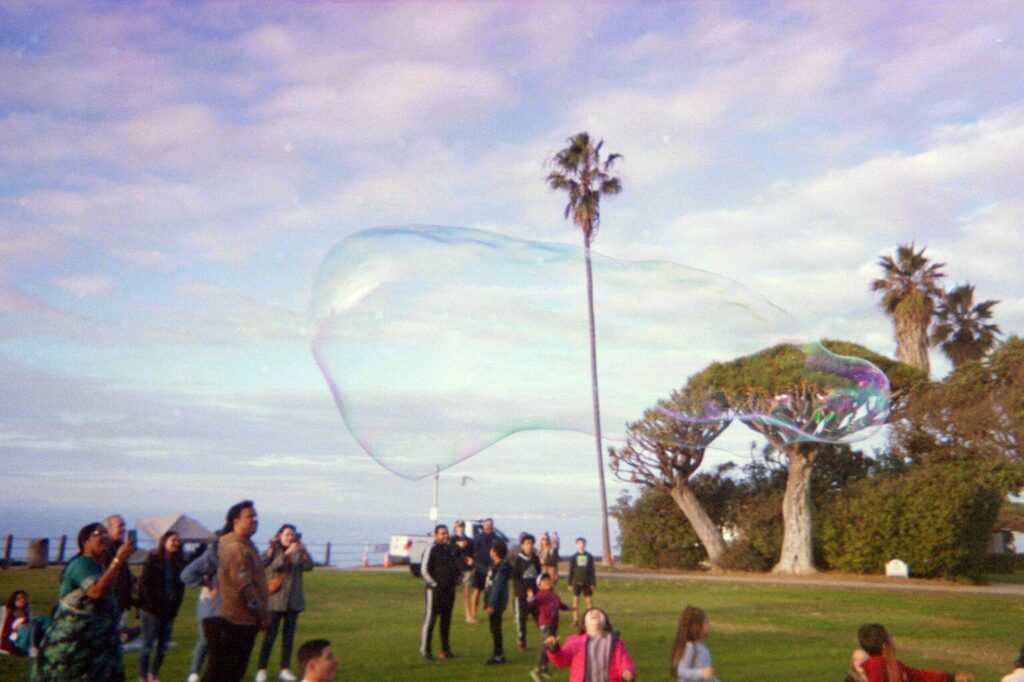
Eric: Bubbles are a good representation of ephemerality. They’re beautiful, but they pop and they’re gone.
Zaina: Exactly. It’s the most beautiful moment of excitement, and then it’s gone in just a few seconds. You really have to be in the moment to enjoy something like that.
Eric: So the pictures were taken before your acknowledgement of the journals theme, right?
Zaina: They were. Yes.
Eric: Okay, so let’s see. Within the last few features and involvements with the journal, can you describe any unexpected or surprising ways in which the theme “Perspectives” has appeared in these photos? Did any new interpretations come after the pictures had already been taken?
Zaina: Yes, after the pictures were taken, my perspective on taking photos and capturing moments really shifted. It made me see the value in photography in general. I started regular photography as a hobby last spring, and that’s when I started taking a lot more photos. But film photography changed my perspective. Now, I see a lot of beauty in those moments that I might not have noticed before. Moments that I’m spending with my family, for instance, I can see a lot of beauty in them. It helps me appreciate that these moments are here and that they will leave, but I think I have an easier time appreciating that they do happen instead of just missing them or being sad that they’re gone.
Eric: Thank you for that.
Emily: I really like the relational aspect that you bring into the stories that you’re sharing with us. This isn’t just you taking photos, this is you with your family, and I can hear the joy in remembering that day and things like that. You mentioned that the camera is your father’s. I’m curious to know if there were any reactions at all? Do you know why he has it in the first place? It doesn’t have to be anything deep if it’s not.
Zaina: Actually, my dad was pretty big into photography when I was a kid. That camera, I’m pretty sure, is from three to four years before I was born. Around when my brother was growing up, he probably took the most photos from it. I have a huge love for vintage type things, and my dad always teases me about it. So when I picked up this camera and started taking photos, it was just another thing that he could tease me about. But I think he doesn’t say it, but maybe it is something special to him because I am carrying that legacy. He doesn’t take as many photos anymore, and I’m assuming it’s because we’re all grown up. My brother is living a separate life, and I’m off to college too. He doesn’t get as many opportunities anymore, but it makes me happy to know that I can follow in his path and do the things that once gave him joy.
Kane: I just want to piggyback off that. Looking back at your father’s old work and your own work, do you see similarities there? How does it change when the camera is given to you? Do you see similarities and differences? I’m curious about that.
Zaina: Actually, I see a lot of differences in the way that my dad and I take photos. My dad’s really into portrait photography, focusing primarily on people. Consequently, our photo albums are filled with pictures of us as kids, and he used to take many photos of my mom. His primary focus was people. My main interest lies in landscapes and moments or things that I find pretty. There’s not a huge motivation behind what I photograph; it’s more of an in-the-moment decision. However, I do notice more differences in the way we take photos. For instance, if he is photographing something that isn’t a person, it’s usually one singular thing, very up close, such as a single flower or tree. I can’t give that any particular meaning, but I find it intriguing that we’re different in that regard.
Emily: Adding to that, I find it fascinating that your dad’s photography mainly captured you and your brother growing up, with one of you being the focal subject at a time. Now that you and your brother are grown up, your dad has stepped back, marking a change in life stage. Similarly, your current stage of life is reflected in your photography. It’s uncertain whether your future photographic style will resemble your dad’s or continue to diverge, but either way is perfectly fine. I find this transition comforting, and it’s interesting to see how he finds beauty in simplicity, similar to your mother.
Zaina: I do find that intriguing as well. I appreciate how you pointed out that his photography could represent a stage in his life, just as my current photographic stage mirrors when he first took up photography. It’s intriguing to think that my photography might resemble his more in the future. If I ever start a family, I can see myself focusing more on the people in my life rather than places. Over time, I believe my attention will shift from the things I see to the people influencing my life. So, that’s an interesting aspect to consider. Thank you for that.
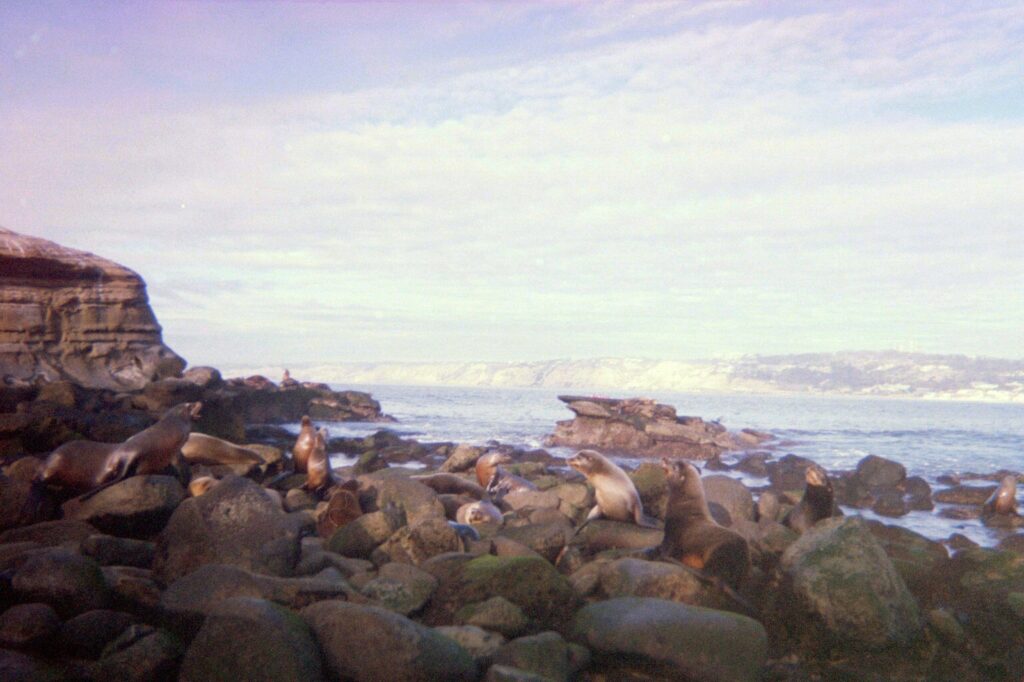
Kane: You made it clear that the photos you’re taking right now are about the real events happening in your life. Looking at these pictures, not only are they real, there’s a sense of surrealism due to the slight tones of purple popping out. It feels even more real, almost hyper-real. I’m curious if this was something you added in post-processing, was it an effect of the actual film, or just a result of the lighting?
Zaina: That’s a great question. Interestingly, the film I used for that roll was an old roll that my dad had with the camera. It’s likely as old as me. So, the purples and random colors are probably a result of the film’s age, which also lends the photos a dreamy quality. If I hadn’t used expired film, they might be less surreal. I think the age of the film really contributed to that. So, I didn’t add anything afterwards because the photos seemed better than I could edit.
Kane: A technical follow-up question: Did your father’s previous photos also have the purple hues, or is it just a result of the film aging?
Zaina: His photos didn’t have the purple hues. I believe the effect resulted from the film’s age when I used it.
Emily: So, the trick is to use old film. That’s the life lesson we’re getting here. I love it.
Eric: Have you used up all of your father’s films?
Zaina: Yes, I have. He only had two rolls, which I used. Recently, I went on vacation and used a roll that wasn’t his. The photos turned out a bit different, less colorful, but still nice.
Eric: The three you submitted, are those your favorite ones that you thought fit?
Zaina: Yes, at the time, those were my three favorites. I’ve taken many more since then, and I’m not sure if they’re better, but they do have a different quality to them. So, there’s something to appreciate in every photo.
Emily: It’s been a while since you took these pictures that you’ve submitted. Now that you have more experience, even with a new roll of film, you can see a difference in what you capture. How have these last couple of months been in terms of taking new photos? How has your thought process and journey through taking photos on film evolved?
Zaina: With this new roll that I’ve just developed, I noticed that the photos seem a bit more dreary or downcast. I’m sure it’s a product of the weather and the lighting. They don’t have that lively, summer feeling to them, as the previous photos did. But, they do symbolize a lot of regrowth and change, which is cool. I haven’t taken photos recently because I’m now recognizing that there are specific things that I want to capture, and I don’t want to waste every roll of film on things that don’t hold a lot of meaning for me. I haven’t been taking as many digital photos either. Last spring, I took so many photos of the things that I liked on campus, especially the flowers and the trees. They’re beautiful, but I didn’t want to retake photos of those things. It’s shifted my perspective on what I want to capture. I plan to put in a new roll of film soon, hopefully before a concert next weekend. And over the summer, if I go anywhere exciting or do more fun things, I’ll take photos of that.
Emily: That’s really interesting. These days, having a camera is so commonplace; just a part of our lives. I appreciate how this conversation is allowing us to slow down and reflect on something that can be so fast-paced.
Zaina: Definitely. Yes.
Eric: I wonder if the fact that everyone has access to a camera on their phone takes away from what makes photography special. In the past, you had to own a camera to take a picture. Now, everyone can just snap a picture of anything. That’s why I think people like to return to film photography; it makes you think twice because it’s finite.
Zaina: Exactly. That’s what encourages me to take photos on film. I think quite a few times before I take a photo.
Eric: Have you ever decided to take a picture of something and then later regretted it?
Zaina: Yes, that has happened a few times, and I have regretted it. I don’t have those photos. But that sort of regret gets overshadowed by the photos I do get back. I completely forget that I ever wanted to take photos of something else. When I get my actual photos back, they’re so nice and remind me of so many good things, I forget that there were photos I didn’t take.
Eric: Do you have an anecdote with any particular photo you took? It doesn’t have to be one that you submitted to us, but a picture you took that perhaps didn’t turn out as well as you had hoped when it was developed?
Zaina: I did take photos on a recent vacation to England. We visited the countryside, which was adorned with picturesque villages and ancient architecture. It was truly beautiful. I was particularly captivated by the bridges, taking numerous photos of them, almost 10 in fact. However, one photo that I somewhat regret is of a stunning bridge with RVs and cars in the background. It was impossible to capture the bridge without including them, which was a little bothersome. Whenever I see that photo, the vehicles are the first thing that grab my attention.
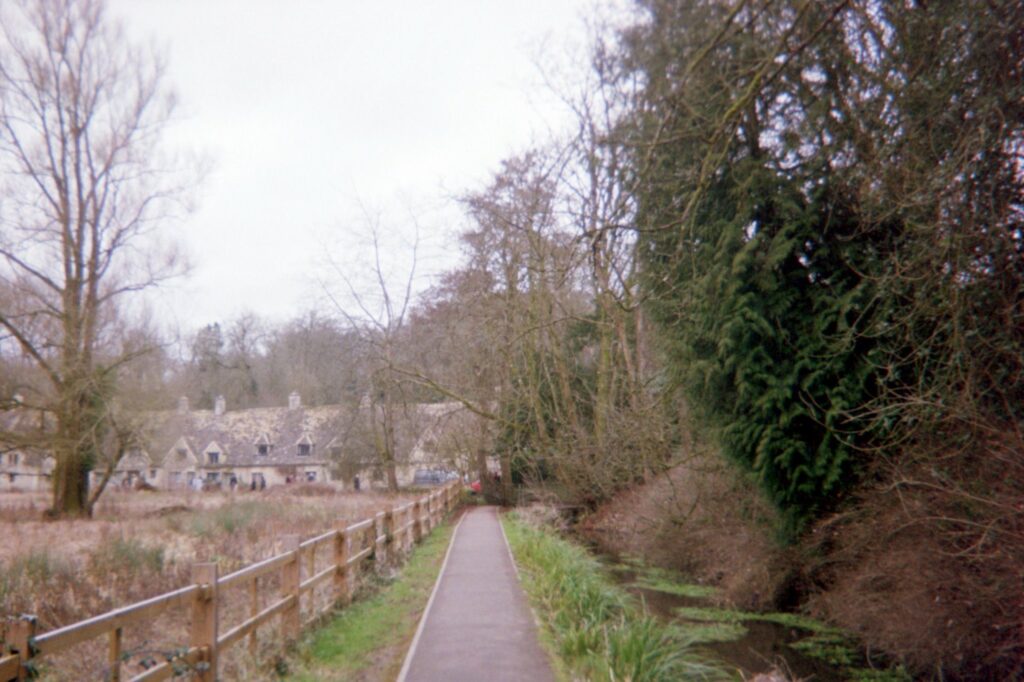
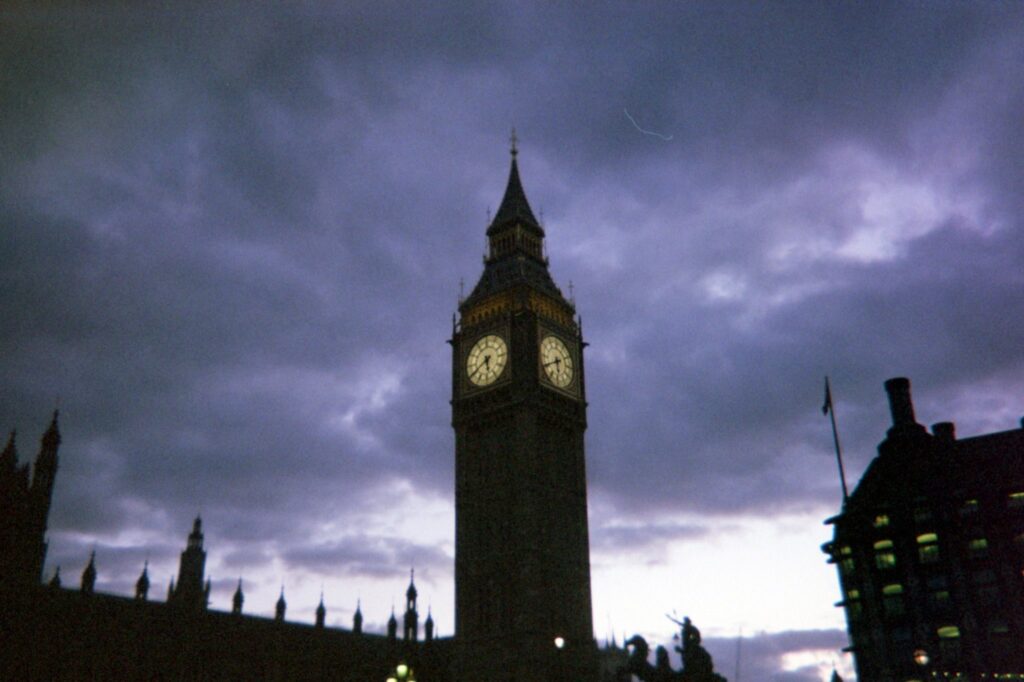
Eric: I’d love to hear more if anything else comes to mind. Photography isn’t just about the final result, but also the experience you have while taking the photos. Sometimes, what happens behind the camera is equally, if not more, interesting. Often, there are stories behind each photo that people don’t see or know about.
Zaina: Actually, I do have a story. Although seemingly unrelated at first, it will make sense. My mother’s uncle is an avid photographer. Even in his 70s, he remains one of the most active people I’ve met. His approach to photography is quite comical. He crouches down and makes all sorts of gestures to get the perfect shot. When he’s taking photos, nothing else matters to him. He doesn’t care if he appears odd or silly, or even ends up lying on the floor. His dedication is unwavering. I experienced a similar moment when I was on a boat on the Thames, trying to photograph the Big Ben at night. I wanted the best angle and a straight image. Despite the moving boat and various other challenges, I crouched down, just like my great-uncle, and did my best. It felt as though I was channeling him in that moment. It’s interesting how photography can connect you with different people across generations. When I take photos, I often think of my great-uncle and my father, who I believe enjoyed photography at some point in his life.
Eric: That’s truly heartwarming. So, it wasn’t just your father, but also your great-uncle who influenced your interest in photography.
Zaina: Indeed, many people in my family are passionate about photography. I never really noticed it until I started taking photos myself. No one pursued it professionally, so it didn’t stand out to me, but it’s a hobby that has been passed down through generations. I guess I inherited the photography gene too.
Kane: In light of that, do you share your final products with your family, like your father or uncle? What is that experience like, sharing these moments? Or do you prefer to keep them to yourself?
Zaina: That’s an interesting question. While it’s not related to my general approach to photography, I must admit that I’m not the biggest sharer. I seldom show my photos to anyone, except on Instagram. There, I know they will be appreciated. However, when I show them to my parents, their reaction is usually just a lukewarm “oh cool.” While I understand that not everyone shares my interest, it’s not the response I hope for. Therefore, I tend to share my photos with people who I know will appreciate them. The photos hold significant meaning for me, so I only share them with a select few — my inner circle.
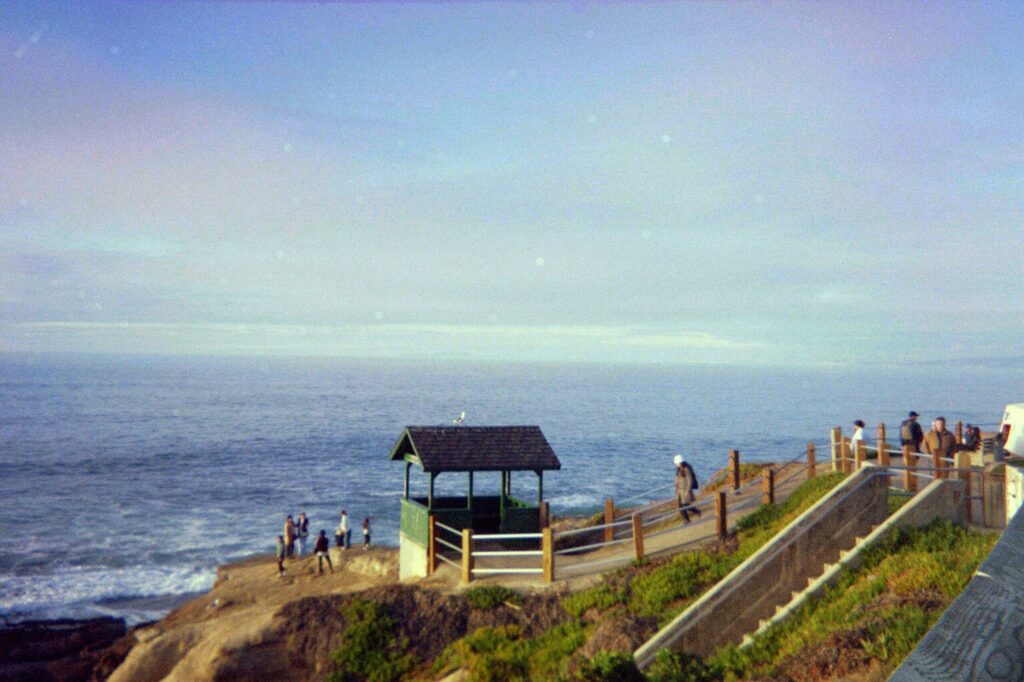
Eric: How does it feel then to take your work down from this private realm and put it out in a journal where it will be seen by many people?
Zaina: It’s actually quite exciting. Strangely, I believe that strangers might appreciate my photos more than the people closest to me. Maybe because those close to me already understand my motivations for taking photos, whereas strangers do not. They might take more interest in learning why these photos were taken and perhaps attach their own meaning and interpretation to them. Additionally, I find it fascinating that I might potentially inspire others to take up photography. I believe it’s an endeavor everyone should try at least once in their life, as it has greatly impacted me.
Eric: That’s a thoughtful perspective. With the privilege of choosing the photos you wish to share, it often seems that people become more anxious or nervous when sharing with those closest to them. With the advent of the internet, however, it’s a different story. Even though the internet can be daunting, it feels like a blank slate where you can start anew, allowing people to form their own impressions of you.
Zaina: That’s probably why I post more online than I share with people close to me. The judgments of those close to me mean a lot more than those of people online. If someone online criticizes my photos, it won’t affect me as much as if my parents, for example, said they didn’t like a photo. It’s definitely harder to share with people closer to me than with others.
Kane: Has anyone ever shit on you [for your photos]?
Zaina: No, that’s never happened. But hypothetically, if it were to happen, it wouldn’t matter to me as much.
Eric: What about people in your personal life, offline?
Zaina: Offline, I would say that the people closest to me don’t have a significant interest in my photos, and that’s fine. However, it does affect how much I share with them and how much I explain about my photos. I have all these thoughts about why I’m taking a photo and what it means to me, but I haven’t really shared or explored this with anyone closer to me. Talking with you guys about this is the first time I’ve ever explained why I’m taking these photos.
Eric: So, going forward, what’s going to keep encouraging you? It doesn’t sound like you have a close social circle that appreciates these photos. And I know it’s a hobby, but what’s going to motivate you from here on out?
Zaina: Probably just myself. Simply taking the photos is very special to me. That would be my motivation to submit if I feel it aligns with the theme of a particular journal. Even if they don’t, I think I would still keep sharing them online. I won’t stop trying to share them with people offline or close to me either. They mean a lot to me, and it feels almost pointless to keep them to myself.
Eric: Moving slightly away from the topic: Have you ever been outside with your camera, used up your entire roll of film, and then felt FOMO when a moment passed that you couldn’t capture?
Zaina: That happens quite often. I once finished a roll while in the English countryside. Everything was so beautiful that I found myself stopping to take a photo every five minutes. The roll finished quite quickly, and I spent the entire ride home thinking about missed photo opportunities. However, I believe it makes the photos I did take even more special because they’re there for a reason.
Eric: What camera do you use again?
Zaina: It’s [a] Fujifilm One Shot Plus.
A message from the editors: Unfortunately, our transcript ended there. And we hope, just like us, you want to read more.
Ephemerality was an interview conducted with Zaina about a series of photographs she submitted to our first issue. What was intended to be a candid conversation about the context, process and history of her photographs and journey through photography, quickly became a conversation that centered around the stillness of photographs and, more broadly, what the act of photography can bring: How one picture, a single shot, can encapsulate so much of a moment — the feelings, the context and the memories.
Zaina reminds us that in a world that has become so fast-paced, and hustle-cultured, it is important to not only appreciate and remember the little moments of our fleeting day-to-day lives, but to share them with those around us.